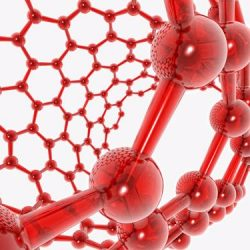Major Nanomaterials Use Cases in Medicine

Medicine is one of the most commonly cited use cases for nanomaterials. Manipulating devices and systems at nanometer scale opens up many possibilities in diagnosing and treating diseases and performing common tests with greater accuracy than before. Years ago, the U.S. National Institutes of Health published a list of some potential applications of nanomaterials in healthcare, many of which have since received greater attention and development, including:
- Highly targeted delivery of genes and drugs.
- Precise engineering and regeneration of bodily tissues.
- Contrast enhancement for MRIs.
- Enhanced detection of proteins and pathogens.
- Fluorescent labeling and tagging of proteins.
These uses are just a sampling of what could be possible in the coming years through the research, refinement and engineering of healthcare-focused nanotechnology. For example, a recent MarketsandMarkets report found that the global market for nanotech-powered medical devices would reach $8.5 billion by 2019, having expanded at an 11 to 12 percent compound annual growth rate from 2014 to 2019.
For engineers considering a career at the intersection of nanomaterials and healthcare, the future is bright, as these projections for medical devices alone suggest. Career opportunities in this space should benefit from the amount of new interest and funding focused on nanotechnologies, as well as the vast size of the U.S. healthcare sector and its need for better overall quality of care.
Healthcare is fertile ground for the nanotech applications of tomorrow
According to the U.S. Bureau of Labor Statistics (BLS), nanotech experts have a particularly good occupational outlook within the larger domain of mechanical engineering, itself already a field with solid prospects. The BLS has forecasted nine percent growth in all mechanical engineer positions from 2016 to 2026, while citing the use of nanomaterials in both medicine and microprocessors as a key driver of projected growth.
Meanwhile, the American healthcare industry should continue to dominate the national economy. The U.S. Centers for Medicare and Medicaid Services (CMS) estimated total health-related spending at $3.3 trillion for 2016, or more than $10,000 per capita. That amount represented 17.9 percent of GDP, up from 17.7 percent the previous year. At that size – much larger than in many other nations in the Organization for Economic Co-operation and Development – there is ample room for cost reductions, perhaps through the application of nanotech for improved treatments.
With an eye toward more cost-effective and beneficial care, CMS now oversees multiple programs incentivizing the delivery of higher quality services by physicians. These initiatives typically hinge on how well providers treat patients with complex conditions and then document their actions via a certified electronic health record (EHR) system. Where do nanomaterials fit into this puzzle? For starters, they might simplify the detection of major maladies such as cancer, heart disease and chronic lower respiratory disease, which collectively account for 75 percent of all deaths each year in the U.S. and create numerous complications beyond that.
The benefits of nanomaterials in preventing and treating disease
A central challenge in the traditional treatment of cancer is in finding and eliminating cancerous cells. Specific therapies, from radiation to chemotherapy, often have substantial side effects and significant costs. With nanomaterials, it might be possible to boost the efficacy of these remedies and inspire new ones as well.
Cancer and nanobots
At Harvard Medical School, a group of researchers successfully built what it called an “origami nanorobot” from DNA. The payload of this creation is a package of molecules carrying instructions for designated cell, usually pertaining to their destruction. Such nanobots have been tested for inducing cell death in tissues afflicted with leukemia and lymphoma.
This general architecture for seeking and destroying individual cells is useful beyond cancer, for some of the disease we mentioned earlier and many others. Gold, which is highly malleable and ductile, can be transformed into star-shaped particles carrying pharmaceuticals. The star shape helps make delivery more precise, in some cases allowing drugs to be administered directly into the nucleus of a cell.
Stem cells
Accurate targeting via nanotech is also promising for harnessing the power of stem cells. For decades, stem cells – which can turn into any type of cell, once developed – have been regarded as a holy grail of medicine, especially for regenerative uses.
In practice, they have proven difficult to apply, since most are rejected by the body and as a result don’t survive being transferred to new environments. Nanomaterials could change that. Synthetic compounds, refined at nanometer scale, could ensure better absorption.
Biofunction monitoring
Nanotechnologies are as good for proactive approaches to medicine as they are for reactive ones. Materials such as graphene could be shaped into wearable monitors transmitting data back to hospital-based systems, streamlining care for elderly patients who often require attention in remote locations.
Along similar lines, nanomaterials might be feasible for monitoring circulating tumor cells, the viable cells derived from tumors long thought to be the precursors metastatic cancers. The key advantages of the nanotech route are scale, flexibility and precision, all of which add up to better diagnoses and treatments. The wearable monitoring capabilities of well-designed nanotech innovations would likely far supersede the current state-of-art for gadgets such as smartwatches, wristbands and smartphones.
What to do if you are considering a career in health-focused nanotechnology
Given BLS projections for mechanical engineering in general and nanoengineering in particular, now is a good time to think about acting on your interests in nanomaterials. While many engineers enter these fields with only a bachelor’s degree, additional credentials can qualify you for advanced positions while also extending your knowledge and technical skill.
An online master’s degree in materials at the nanoscale is your ticket to success in a rapidly evolving sector of the economy. Learn more by visiting UC Riverside’s Nanotechnology program page, where you can also sign up for updates from us.
Recommended Reading
Sources
https://www.nanowerk.com/spotlight/spotid=47031.php
https://www.medicalnewstoday.com/articles/244972.php
https://www.marketsandmarkets.com/PressReleases/nanotechnology-medical-device.asp
https://ryortho.com/breaking/nanotechnology-may-lead-to-tissue-regeneration/
https://www.bls.gov/ooh/architecture-and-engineering/mechanical-engineers.htm#tab-4